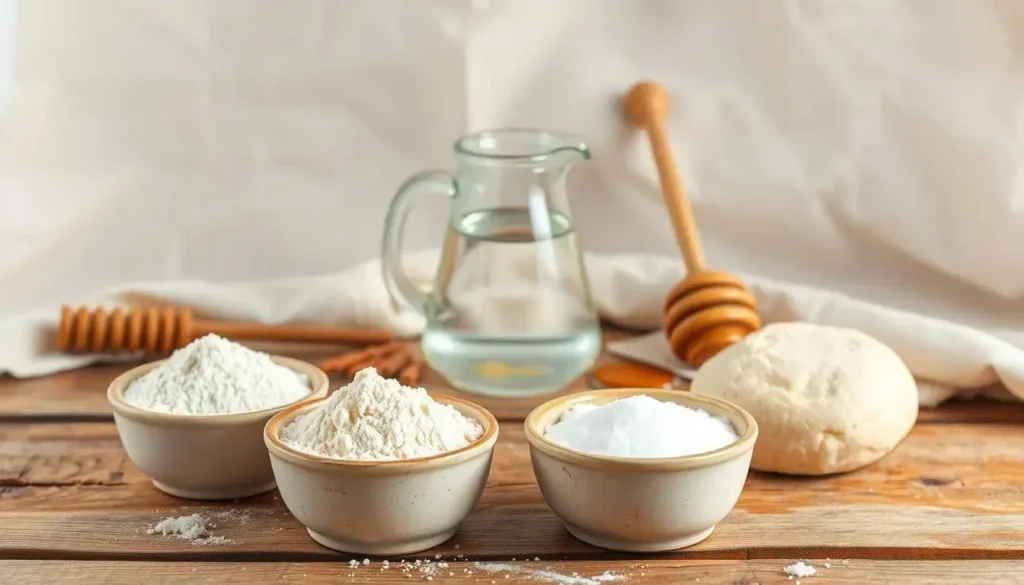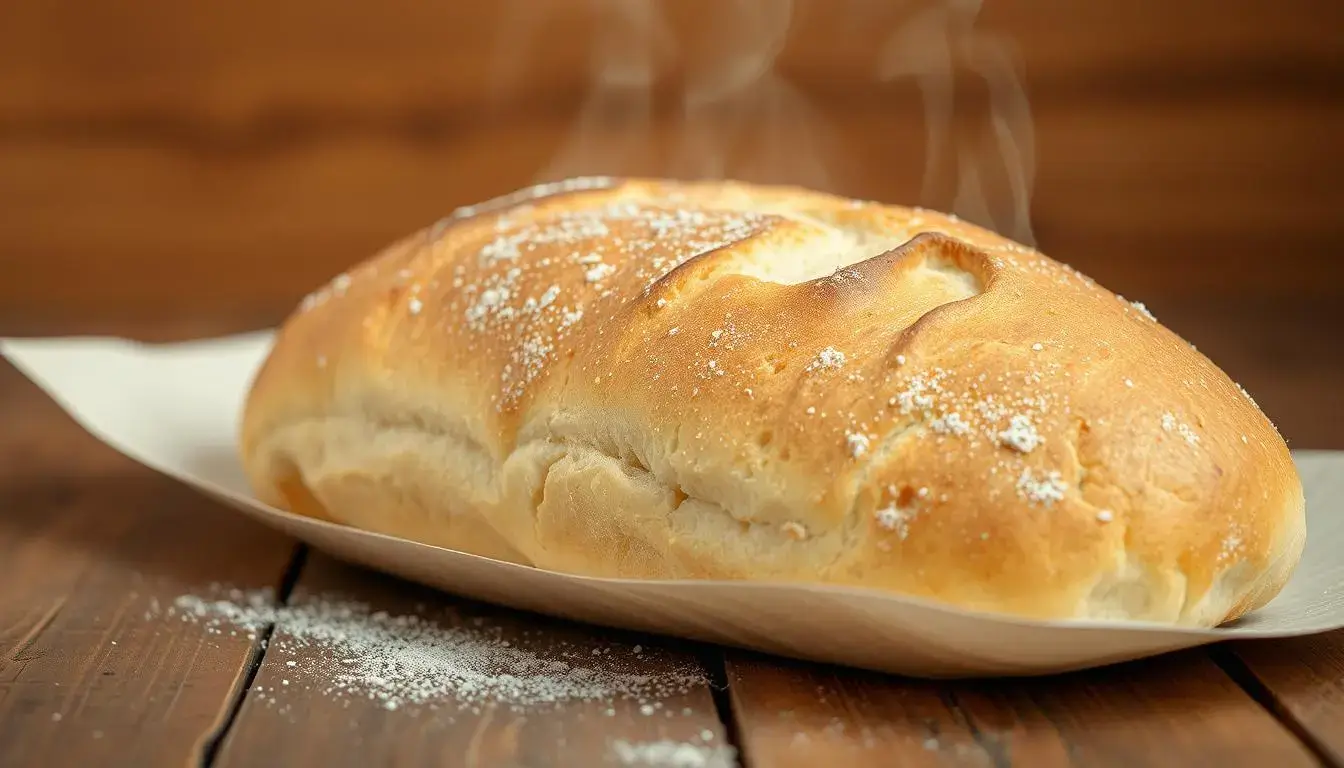Sandwich Bread Recipe: The smell of fresh sandwich bread takes us back to our childhood. I recall watching my grandmother knead dough with her hands. She turned simple ingredients into a magical loaf that filled our home with comfort and love.
Making your own sandwich bread is more than just cooking. It’s about creating a special experience. This recipe will help you make your own bread at home. It’s perfect for both beginners and experienced bakers.
Baking bread might seem hard, but it’s actually quite simple. With the right techniques and patience, you’ll enjoy warm, golden bread that’s much better than store-bought.
Key Takeaways
- Homemade sandwich bread offers superior flavor and freshness
- Basic ingredients create extraordinary results
- Baking bread is simpler than most people realize
- Fresh bread connects us to traditional cooking methods
- You can customize your sandwich bread with unique ingredients
Essential Ingredients for Perfect Sandwich Bread
Making great homemade sandwich bread begins with the right ingredients. The quality of your bread depends on choosing the best parts. These components should work together to make a soft, tasty loaf that makes your sandwiches better.

Let’s look at the main ingredients that turn simple parts into amazing homemade sandwich bread:
Understanding Different Types of Flour
Flour is the base of any sandwich bread recipe. You have several options:
- All-Purpose Flour: Versatile and easy to find
- Bread Flour: Has more protein for a better texture
- Whole Wheat Flour: Adds nutrition and a nutty taste
“The right flour can make or break your homemade sandwich bread” – Professional Baker
The Role of Yeast and Sugar
Yeast is the magic that makes bread rise. Active dry yeast or instant yeast are best for sandwich bread. Sugar helps the yeast grow and makes the bread soft and tender.
Optional Add-ins for Enhanced Flavor
Make your homemade sandwich bread even better with these creative extras:
- Honey for a natural sweetness
- Olive oil for extra moisture
- Herbs like rosemary or thyme
- Seeds such as sesame or poppy
Trying out these ingredients can help you make unique sandwich bread recipes. This way, you can find the perfect taste for you.
Required Kitchen Tools and Equipment
To make the perfect sandwich bread, you need the right tools. You’ll need several key items for a smooth process and tasty results.

For your basic sandwich bread recipe, you’ll need some important equipment. These tools help both professional bakers and home cooks make perfect loaves.
- Large mixing bowl (glass or stainless steel)
- Measuring cups and spoons
- Kitchen scale for precise ingredient measurements
- Loaf pan (9×5 inch recommended)
- Stand mixer or wooden spoon for kneading
- Clean kitchen towel
- Cooling rack
Choose quality tools that will last. A good kitchen scale is key for your sandwich bread. It ensures consistent results by measuring ingredients precisely.
| Tool | Purpose | Recommended Type |
|---|---|---|
| Mixing Bowl | Combining ingredients | Large, non-reactive material |
| Loaf Pan | Bread shaping and baking | 9×5 inch, non-stick |
| Kitchen Scale | Precise ingredient measurement | Digital with gram/ounce setting |
“The right tools transform a good sandwich bread recipe into an extraordinary baking experience.” – Professional Baker
You don’t need every tool to make sandwich bread. Many home bakers use basic equipment. The important thing is knowing how each tool helps make a perfect loaf.
Mastering the Sandwich Bread Recipe
Making the perfect homemade sandwich bread needs precision and care. Your journey starts with understanding key techniques. These techniques turn simple ingredients into a delicious loaf. Each step is crucial for flavor and texture.
Proper Kneading Techniques
Kneading is key to a great sandwich bread texture. Work on making the dough smooth and elastic. Aim for 8-10 minutes of hand kneading or 5-7 minutes with a stand mixer. This develops gluten, which makes bread firm.
- Use the heel of your hand to push and fold the dough
- Rotate the dough quarter-turn after each knead
- Test gluten development by performing the “windowpane test”
First and Second Rise Tips
The rising process is vital in homemade sandwich bread recipes. Yeast needs time and warmth to create air pockets. These make bread light and fluffy.
| Rise Stage | Temperature | Duration |
|---|---|---|
| First Rise | 75-80°F | 1-1.5 hours |
| Second Rise | 80-85°F | 45-60 minutes |
“Patience is the secret ingredient in bread making” – Professional Baker
Shaping Your Loaf
Shaping affects your bread’s look and structure. Flatten the dough into a rectangle, then roll it into a log. Pinch the seams to seal and place in a greased loaf pan for even distribution.
- Deflate dough after first rise
- Shape into a uniform rectangle
- Roll tightly from short end
- Seal edges carefully
Baking Temperature and Timing Guide
Getting your sandwich bread just right needs the right baking techniques. The perfect temperature and timing can make a big difference. Knowing your oven well is key for that golden crust and soft inside.
Preheat your oven to 375°F (190°C) for most sandwich bread recipes. This temperature helps bake evenly and creates a beautiful crust. Make sure to use an oven thermometer to check the actual temperature, as ovens can be off.
- Standard baking time: 30-35 minutes
- Check internal bread temperature: 190-200°F (88-93°C)
- Look for a deep golden-brown exterior
Loaf sizes can affect baking time. Larger loaves might need 5-10 minutes more. Use these signs to know when it’s done:
| Bread Characteristic | Ideal Indicator |
|---|---|
| Crust Color | Deep golden brown |
| Sound Test | Hollow sound when tapped |
| Internal Temperature | 190-200°F |
Professional bakers suggest rotating your bread halfway through baking. This ensures even browning. If the top gets too dark, cover it with foil to prevent burning.
Pro tip: Always let your bread cool completely on a wire rack before slicing. This keeps its texture perfect and prevents soggy bottoms in your sandwich bread recipe.
Storage Tips and Shelf Life
Keeping your homemade sandwich bread fresh is key. It needs careful storage and handling. This way, your loaf stays delicious and soft.
Choosing the right storage can make your bread last longer. This ensures you get to enjoy every slice fully.
Optimal Storage Containers
Finding the perfect storage container is important. Here are some great choices:
- Bread boxes with ventilation
- Plastic containers with tight-sealing lids
- Cotton bread bags
- Resealable plastic bags
Freezing Your Homemade Bread
Freezing is a great way to keep your bread fresh for longer. Just follow these easy steps:
- Cool the bread completely before freezing
- Slice the bread before freezing
- Wrap tightly in plastic wrap or aluminum foil
- Place in a freezer-safe bag
- Store for up to 3 months
Recognizing Bread Spoilage
Always check your homemade sandwich bread for spoilage signs. Look out for:
- Visible mold spots
- Unusual smell
- Hard or excessively dry texture
- Unusual discoloration
By using these storage tips, you can keep your homemade sandwich bread fresh. Enjoy fresh, tasty slices for days.
Conclusion
Making your own sandwich bread is more than baking. It’s about creating a tasty experience in your kitchen. Your homemade bread shows your skill, passion, and creativity in cooking.
Learning this recipe opens up new possibilities. You’ll love making a warm, fragrant loaf that’s better than store-bought.
- Save money on store-bought bread
- Control ingredients and nutrition
- Enjoy fresh bread anytime
- Impress family and friends
Your bread-making journey doesn’t stop with one recipe. Try different flours, add seeds, or make whole grain versions. Each batch teaches you something new about baking.
“Baking bread is an art that connects us to generations of home cooks who found joy in creating something truly special.”
Don’t worry if your first loaf isn’t perfect. Each try brings you closer to being a bread-baking pro. Enjoy the journey, the delicious outcomes, and make homemade sandwich bread a special part of your cooking routine.
Frequently Asked Questions About Homemade Sandwich Bread
When you start making sandwich bread, you might face some common issues. It can seem tricky to get that perfect loaf. But, knowing a few key tips can make your homemade bread truly stand out.
Why does your bread end up dense? It usually happens when yeast isn’t activated right or the dough isn’t kneaded enough. Your recipe needs the right temperature and careful kneading to build strong gluten. Bakers say to let the dough rise in a warm, still place for the best texture.
Altitude can really affect how your bread turns out. At higher places, you might need to change how much liquid you use and how long it rises. You might also need to tweak your recipe, like using less yeast or more flour. Trying small batches helps you figure out what works best in your kitchen.
Even with dietary limits, you can still make tasty bread. For gluten-free, try using almond, coconut, or special gluten-free flours. Vegan options like flaxseed can replace eggs in most recipes. The key is to know how ingredients work together and be ready to adjust.
FAQ
How long does homemade sandwich bread typically last?
Homemade sandwich bread stays fresh for 3-5 days at room temperature in an airtight container. For longer freshness, refrigerate it for up to a week or freeze for 3 months.
Can I make this sandwich bread recipe without a stand mixer?
Yes, you can make sandwich bread without a stand mixer. Use a wooden spoon and your hands for kneading. This method takes 10-12 minutes and strengthens the bread’s gluten.
What type of flour works best for sandwich bread?
Bread flour is best for sandwich bread because it has more protein. This helps create a strong gluten structure. All-purpose flour also works well. For a healthier option, use up to 50% whole wheat flour.
How can I tell if my yeast is still active?
To check yeast activity, mix it with warm water (100-110°F) and a bit of sugar. If it becomes foamy and doubles in 5-10 minutes, it’s active. If not, it’s dead and needs replacing.
Can I make this bread gluten-free?
Yes, make a gluten-free version with a commercial gluten-free flour blend. These blends have xanthan gum for gluten-like binding. Adjust liquid ratios and expect a different texture.
Why did my bread turn out dense and heavy?
Dense bread can come from not rising enough, old yeast, too much flour, or not kneading enough. Follow the recipe closely and give the dough enough rising time in a warm, draft-free spot.
How do I achieve a golden-brown crust?
For a golden crust, brush the loaf with an egg wash before baking. Or, brush with melted butter after baking for a rich look.
Can I add seeds or herbs to my sandwich bread?
Yes! Add seeds like sesame or poppy during mixing. Dried herbs like rosemary or thyme can also be added for unique flavors.
What’s the best way to slice homemade bread?
Cool your bread completely before slicing. Use a serrated knife and saw gently, not press down. For even slices, use a bread slicing guide.
How can I prevent my bread from going stale quickly?
Store bread in a bread box or paper bag at room temperature. Avoid plastic bags to prevent mold. Freeze it if you won’t eat it in a few days
Cottage Cheese Flatbread Recipes: Explore Delicious and Healthy Options

